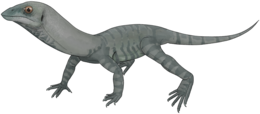Tanystropheid
Tanystropheidae
Extinct family of reptiles
Tanystropheidae is an extinct family of archosauromorph reptiles that lived throughout the Triassic Period, often considered to be "protorosaurs". They are characterized by their long, stiff necks formed from elongated cervical vertebrae with very long cervical ribs. Members of the group include both terrestrial and aquatic forms. While some tanystropheids were small lizard-like animals, other tanystropheids such as Tanystropheus were large animals that had necks that were several meters long, longer than the rest of their bodies.
Tanystropheids are known from Europe, Asia (Russia, China, and Saudi Arabia), North America[5] and probably South America (Brazil).[6] The presence of tanystropheids in Europe and China indicate that they lived along much of the coastline of the Tethys Ocean.[7] However, species in western North America are found in terrestrial deposits, suggesting that as a group, tanystropheids were ecologically diverse.[5]
Relationships among tanystropheid species have been difficult to resolve because most specimens were flattened during fossilization and are preserved two-dimensionally. Three-dimensional fossils are known from Europe and North America.[5]

